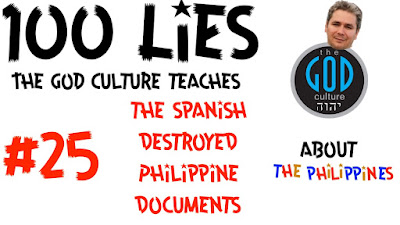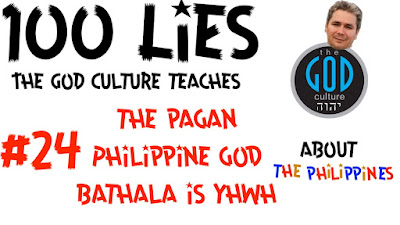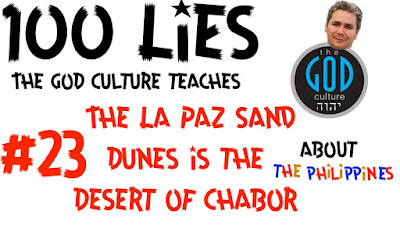Welcome back to 100 Lies The God Culture teaches about the Philippines. Today's lie concerns the Butuan Ivory Seal. This artifact was found in 1970 and dates back to 1,000 AD. Tim says the scholarly interpretation of the seal is wrong and that the writing on it is actually Hebrew. More than that he claims the seal is concrete evidence the Lost Tribes of Israel arrived in the Philippines.
Tim concludes his interpretation of the Butuan Ivory Seal saying:
 |
Lost Tribes Series Part 2F: Decoding the Butuan Ivory Seal - Evidence |
19:24 These letters are about as clear as it gets. They are Hebrew. So, what does all of this mean? Again, read right to left: "The Rechabites who live in tents in the land of creation as the Zadok priests where the scattered tribes are yoked at the ends of the earth." Wow dude! This is awesome and concrete evidence, we believe, that the Lost Tribes arrived in the Philippines.
Despite Tim's conviction that the Butuan Ivory Seal has Hebrew writing and is concrete evidence the Lost Tribes of Israel arrived in the Philippines he does not mention this tidbit in his book The Search for King Solomon's Treasure. There is only a single picture of the seal on page 157.
 |
| The Search for King Solomon's Treasure, pg. 157 |
It is important to note that in this video Tim admits he is not a linguist.
5:06 We are not linguists nor do we care to be but you will find no linguist is necessary in this case because come along with us and we'll interpret this together.
For someone who uses linguistics to prove that there are Hebrew place names in the Philippines Tim is quite proud and satisfied to not actually be a linguist. In effect Tim is admitting he has no idea what he is talking about. Why would there be Hebrew carved into an ivory seal in the Philippines dating back to 1,000 AD? For Tim it's because he believes that members of the Lost Tribes of Israel made their way to the Philippines. That is the fact he starts with and then he interprets everything in light of that false paradigm.
The fact is this seal has already been examined and interpreted by actual linguists. Tim rejects their interpretations full stop.
0:35 Are we crazy? Can we actually claim to have deciphered the writing on the Butan Ivory Seal as we do in the intro? Well, we do indeed with all confidence because all of these years we believe the professors and scholars have been using the wrong language. They don't know any better. It's okay but you and I do.
According to the National Museum of the Philippines Dutch linguist Antoon Postma the script on the seal is stylised Kawi and translates as But-ban which is the same as Butuan.
This week we are featuring the Butuan Ivory Seal, which is dated A.D. 10th-13th c. (Age of Contact and Trade), measuring 6 cm long and 4 cm diameter.The Butuan Ivory Seal was recovered by pothunters in a prehistoric shell midden site in Ambangan, Libertad, Butuan City in the 1970s. It was eventually donated to the National Museum.According to Dr. Antoon Postma, the inscription is an ancient Javanese or stylized Kawi script referring to “But-ban”. A Dutch Scholar in ancient Indonesian scripts, Johannes Gijsbertus de Casparis, decoded it as “But-wan”. These words refer to Butuan, the present name of the site where it was found.The ivory seal as well as other archaeological materials recovered in Ambangan archaeological sites are proof that Butuan was an important trading center whose official seal marked the source of commodities it produced and exported.
It is a rather straightforward interpretation. But Tim rejects it by asking the following question.
20:10 Notice the letter sounds are BT. Could be Butuan, maybe. Perhaps. But why would it need to say Butuan anyway? That's a rush to judgment scholars are trying to stretch out of it unsuccessfully. None of them have proven that it says that for reason.
Well, why does the seal have to say "The Rechabites who live in tents in the land of creation as the Zadok priests where the scattered tribes are yoked at the ends of the earth?" What practical use is having that on the seal? The museum tells us the seal says Butuan because "Butuan was an important trading center whose official seal marked the source of the commodities it produced and exported."
Aside from translating the Butuan Ivory Seal Antoon Postma also deciphered the Laguna Copperplate Inscription.
 |
| https://www.jstor.org/stable/42633308 |
It is interesting that Tim rejects Postma's interpretation of the Butuan Ivory Seal but accepts his interpretation of the Laguna Copperplate. He even includes it in his book.
 |
| The Search for King Solomon's Gold, pg. 156 |
The Laguna Copperplate Inscription, one of the oldest historical records in the history of the Philippines, demonstrates early connections between the early inhabitants of Luzon and Java in Indonesia by the 10th century as well as proving a literate people executing an extensive legal agreement inscribed on a sheet of copper, an abundant native resource. Natives in loin clothes do not draft such significant legal agreements on copper.
And in what language is the Laguna Copperplate Inscription? Kawi!
 |
| https://www.jstor.org/stable/42633308 |
The very same script on the Butuan Ivory Seal.
5:20 We've read a book a while ago and have picked it back up again recently from one of our viewers it's called Philippines, I Thee Wed which is a beautiful way to describe the relationship between the Lost Tribes and the ekklesia the bride of Messiah as scripture references many times over and we have found a former name in fact of the Philippines this is gonna blow you away that is actually Hebrew as well and we will share this soon not in this video but one of the upcoming ones and you're gonna love it because it ties to all of this as well the book makes outrageous claims that Philippines might actually be Ophir maybe even the Garden of Eden and the location of the Lost Tribes hmm can you imagine that?
 |
| Philippines, I Thee Wed, pg. 60 |
It is simply not true that the Butuan Ivory Seal has Hebrew writing on it. It is in Kawi the same as the Laguna Copperplate inscription. Both have been translated by Antoon Postma who, unlike Tim, was an actual linguist. The fact that Tim is unaware that Antoon Postma deciphered both the Laguna Copperplate Inscription and the Butuan Ivory Seal using the same language is more evidence of his poor research skills. The claim that the Butuan Ivory Seal has Hebrew writing on it is just one more lie Timothy Jay Schwab teaches about the Philippines.






























